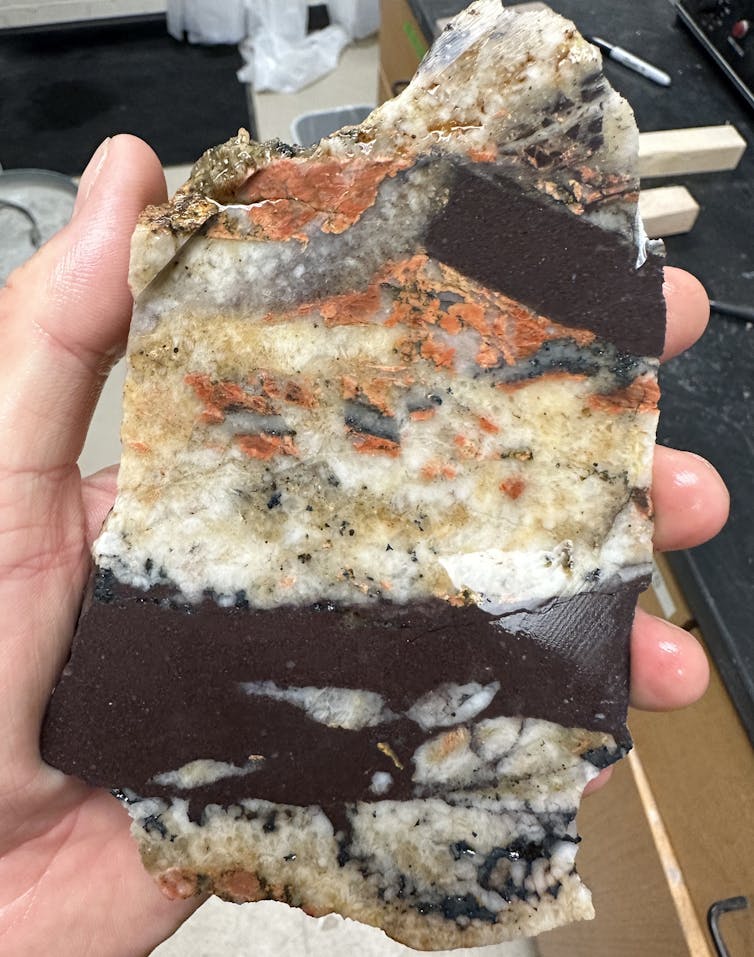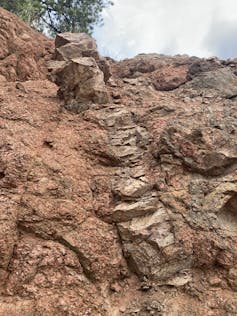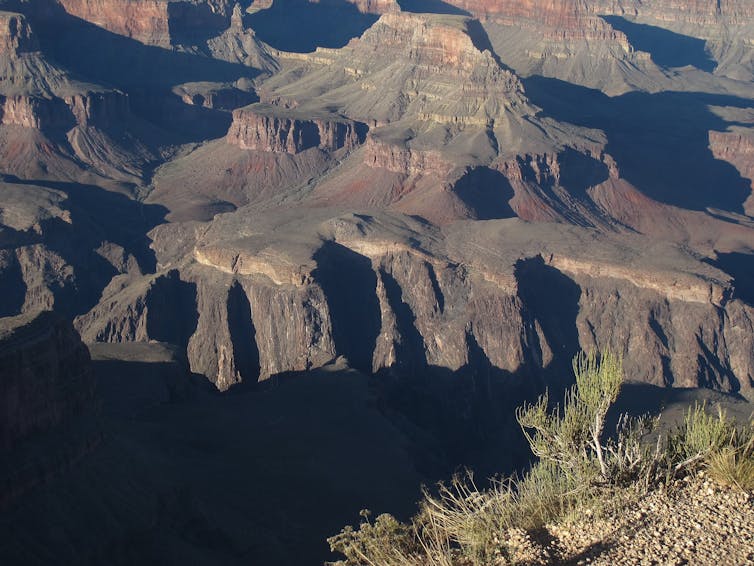Round 700 million years in the past, the Earth cooled a lot that scientists consider large ice sheets encased the whole planet like an enormous snowball. This world deep freeze, often known as Snowball Earth, endured for tens of thousands and thousands of years.
But, miraculously, adolescence not solely held on, however thrived. When the ice melted and the bottom thawed, advanced multicellular life emerged, finally resulting in life-forms we acknowledge at this time.
The Snowball Earth speculation has been largely based mostly on proof from sedimentary rocks uncovered in areas that after have been alongside coastlines and shallow seas, in addition to local weather modeling. Bodily proof that ice sheets lined the inside of continents in heat equatorial areas had eluded scientists – till now.
In new analysis printed within the Proceedings of the Nationwide Academy of Sciences, our staff of geologists describes the lacking hyperlink, present in an uncommon pebbly sandstone encapsulated throughout the granite that types Colorado’s Pikes Peak.
Earth froze throughout the Cryogenian Interval, however life on the planet survived.
NASA illustration
Fixing a Snowball Earth thriller on a mountain
Pikes Peak, initially named Tavá Kaa-vi by the Ute folks, lends its ancestral title, Tava, to those notable rocks. They’re composed of solidified sand injectites, which fashioned in an identical method to a medical injection when sand-rich fluid was compelled into underlying rock.
A attainable rationalization for what created these enigmatic sandstones is the immense strain of an overlying Snowball Earth ice sheet forcing sediment blended with meltwater into weakened rock beneath.

Darkish pink to purple bands of Tava sandstone dissect pink and white granite. The Tava can be cross-cut by silvery-gray veins of iron oxide.
Liam Courtney-Davies
An impediment for testing this concept, nonetheless, has been the dearth of an age for the rocks to disclose when the fitting geological circumstances existed for sand injection.
We discovered a method to clear up that thriller, utilizing veins of iron discovered alongside the Tava injectites, close to Pikes Peak and elsewhere in Colorado.

A 5-meter-tall, nearly vertical Tava dike is obvious on this part of Pikes Peak granite.
Liam Courtney-Davies
Iron minerals include very low quantities of naturally occurring radioactive parts, together with uranium, which slowly decays to the aspect lead at a recognized price. Latest developments in laser-based radiometric relationship allowed us to measure the ratio of uranium to guide isotopes within the iron oxide mineral hematite to disclose how way back the person crystals fashioned.
The iron veins seem to have fashioned each earlier than and after the sand was injected into the Colorado bedrock: We discovered veins of hematite and quartz that each lower by Tava dikes and have been crosscut by Tava dikes. That allowed us to determine an age bracket for the sand injectites, which will need to have fashioned between 690 million and 660 million years in the past.
So, what occurred?
The timeframe means these sandstones fashioned throughout the Cryogenian Interval, from 720 million to 635 million years in the past. The title is derived from “cold birth” in historical Greek and is synonymous with local weather upheaval and disruption of life on our planet – together with Snowball Earth.
Whereas the triggers for the acute chilly at the moment are debated, prevailing theories contain adjustments in tectonic plate exercise, together with the discharge of particles into the environment that mirrored daylight away from Earth. Finally, a buildup of carbon dioxide from volcanic outgassing might have warmed the planet once more.
College of Exeter professor Timothy Lenton explains why the Earth was capable of freeze over.
The Tava discovered on Pikes Peak would have fashioned near the equator throughout the coronary heart of an historical continent named Laurentia, which step by step over time and lengthy tectonic cycles moved into its present northerly place in North America at this time.
The origin of Tava rocks has been debated for over 125 years, however the brand new expertise allowed us to conclusively hyperlink them to the Cryogenian Snowball Earth interval for the primary time.
The state of affairs we envision for the way the sand injection occurred appears to be like one thing like this:
An enormous ice sheet with areas of geothermal heating at its base produced meltwater, which blended with quartz-rich sediment beneath. The load of the ice sheet created immense pressures that compelled this sandy fluid into bedrock that had already been weakened over thousands and thousands of years. Just like fracking for pure fuel or oil at this time, the strain cracked the rocks and pushed the sandy meltwater in, finally creating the injectites we see at this time.
Clues to a different geologic puzzle
Not solely do the brand new findings additional cement the worldwide Snowball Earth speculation, however the presence of Tava injectites inside weak, fractured rocks as soon as overridden by ice sheets supplies clues about different geologic phenomena.
Time gaps within the rock report created by erosion and known as unconformities could be seen at this time throughout america, most famously on the Grand Canyon, the place in locations, over a billion years of time is lacking. Unconformities happen when a sustained interval of abrasion removes and prevents newer layers of rock from forming, leaving an unconformable contact.

Unconformity within the Grand Canyon is obvious right here the place horizontal layers of 500-million-year-old rock sit on prime of a mass of 1,800-million-year-old rocks. The unconformity, or ‘time gap,’ demonstrates that years of historical past are lacking.
Mike Norton through Wikimedia, CC BY-SA
Our outcomes help {that a} Nice Unconformity close to Pikes Peak will need to have been fashioned previous to Cryogenian Snowball Earth. That’s at odds with hypotheses that attribute the formation of the Nice Unconformity to large-scale erosion by Snowball Earth ice sheets themselves.
We hope the secrets and techniques of those elusive Cryogenian rocks in Colorado will result in the invention of additional terrestrial information of Snowball Earth. Such findings can assist develop a clearer image of our planet throughout local weather extremes and the processes that led to the liveable planet we stay on at this time.